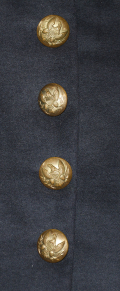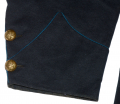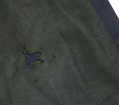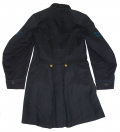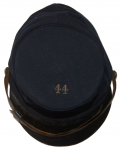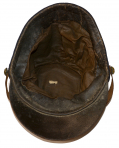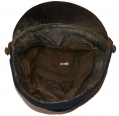site search
online catalog
ID’D US FROCK COAT AND FORAGE CAP – CORPORAL ALFRED CARPENTER, 44th MASSACHUSETTS (EX-TEXAS MUSEUM COLLECTION)
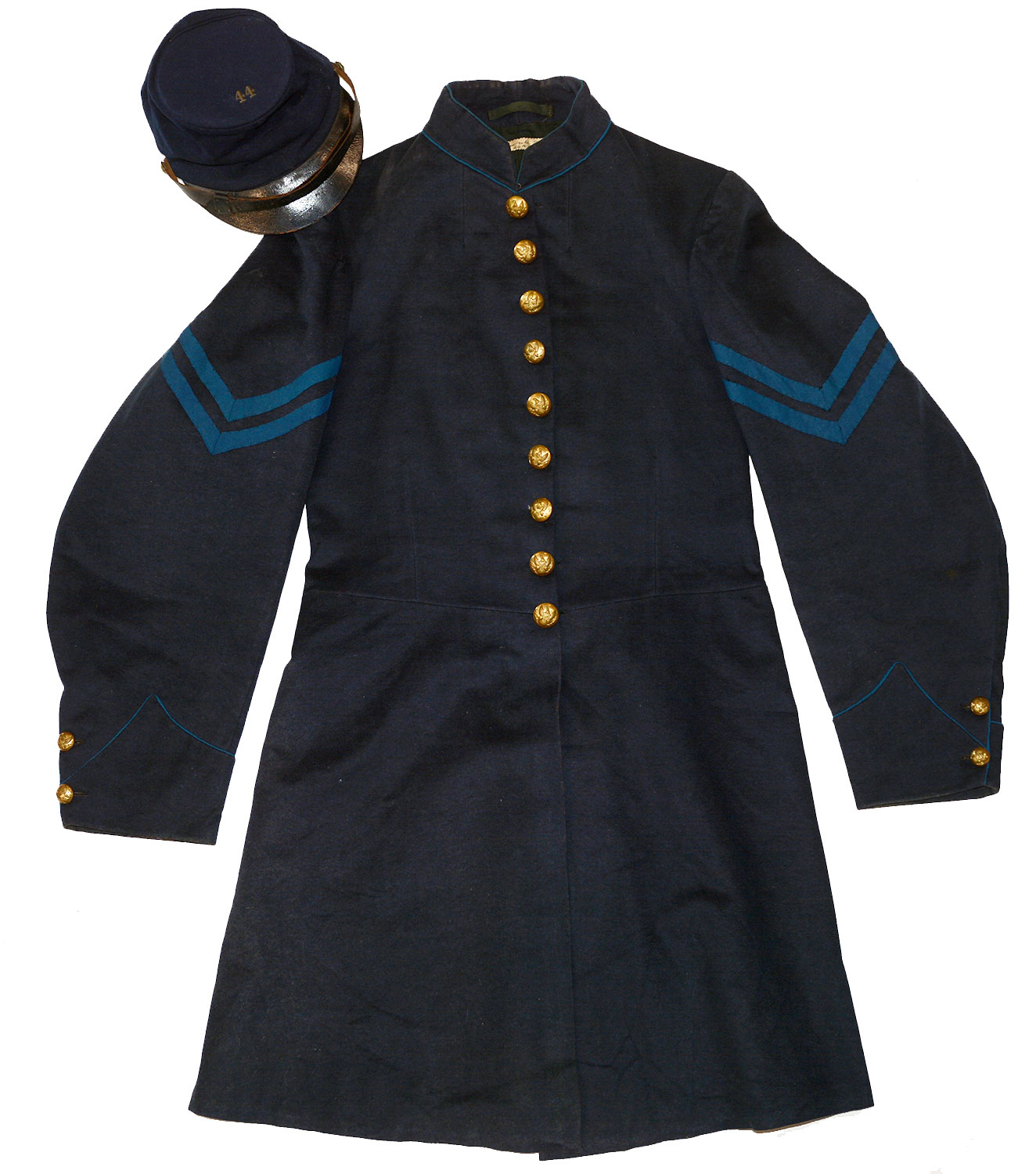
$14,950.00 SOLD
Quantity Available: None
Item Code: 1268-266
The 44th Massachusetts was born of the 4th Battalion of Massachusetts Volunteer Militia, a unit formed at the outset of the American Revolution which called itself the “New England Guards”. Before Lincoln issued his August of 1862 call for 9-month volunteers, the 4th Battalion was already providing garrison troops for Fort Independence. The 4th was able to field a full regiment within a few weeks and subsequently became the 44th Massachusetts Regiment of Volunteers. They trained near Boston before being assigned to the Department of North Carolina in October of 1862 where they were primarily stationed at New Bern, North Carolina and saw their first combat during the Battle of Rawl's Mills in November 1862. In December, the regiment took part in the Goldsborough Expedition, the objective of which was to disrupt the Confederate supply line along the Wilmington and Weldon Railroad by destroying the Goldsborough Bridge. During this expedition, the regiment was engaged in the Battles of Kinston and Goldsborough Bridge. In March and April 1863, they participated in the Siege of Washington, North Carolina. In late April, the regiment moved to New Bern where, for the next two months, they participated in patrols and reconnaissance expeditions. By June of 1863, the regiment mustered out near Boston but was called upon shortly thereafter to be sent to New York City to police the city during the infamous draft riots. After a week in New York City, they returned to the Boston area and their duty was concluded. While in North Carolina, the regiment lost 12 killed in combat and 29 to disease.
Alfred was a 20-year-old clerk who resided in Boston when he enlisted on August 29th, 1862. On September 12th, he mustered into Company C of the 44th Massachusetts. He received a promotion to Corporal on December 16th, 1862. He continued to serve with the unit through all major actions and the New York Draft Riots, officially mustering out on June 18th, 1863 in Readville, Massachusetts. He recorded his experiences in detail in his diary from August 29th through the end of his service term. He talks of the miseries of the troop transports en route to North Carolina, and being armed with Enfield Rifle-Muskets captured from a British steamer. He seemed to have abolitionist sentiments – repeatedly discussing respectful interactions with African-Americans in North Carolina. His experience during the Goldsboro Expedition was punctuated by the constant presence of Confederates, who feigned assaults and kept up continual harassment with the firing of artillery and attacks on small Union foraging and reconnaissance details isolated by the complex network of rivers and tidal basins.
At the battle of Goldsboro Bridge, the 44th was hotly engaged, with Alfred’s Company taking point during an advance toward the bridge while in line next to the 10th Connecticut. The lively accounting mentions trading fire with unseen rebel sharpshooters while lying exposed in a swampy field to avoid incoming fire. As the regiment continued the advance, they reached the crest of a hill and saw the bulk of the action around the bridge. As Union General Foster’s forces advanced, they fired and overwhelmed the Confederate defenders and accomplished their objective of destroying the important rail line bridge. Alfred’s company lost 2 men killed – a Sergeant and a Private – and a Corporal was severely wounded. The 400 combat effectives of the 10th Connecticut lost nearly 100 men.
He talks at length about returning to New Bern and his ventures into the interior of North Carolina - taking prisoners, capturing materiel, and the earie feelings of being under continual threat in a hostile territory. His account of the Siege of Washington, NC is filled with interesting details of constructing breastworks and fortifications, exhaustive marches, being part of volunteer scouting parties sent ashore in various places to ascertain the presence of Confederates, and riding on various gunboats and transport ships in the tidewater area sent to check imposing rebel land batteries and fortifications. As told by Alfred, the sporadic fighting took a slow toll on the US regiments, with regular but small numbers of killed and wounded as men went ashore in various places – sometimes unopposed and sometimes meeting small but determined parties of the enemy. His duty in New Bern saw him guarding prisoners, being quartered in local homes and buildings which had been abandoned, and trying to find escape from the challenges of the coastal weather. As he returned to Boston, he was obviously full of pride in his service while relieved to be going home.
This remarkable grouping includes Alfred’s Forage Cap, which features a McDowell brim, a leather chinstrap, and unit insignia. The cap is made of a modest weight broadcloth with a tight weave, and the interior is lined in a brown polished cotton. The leather chinstrap is secured by Federal Eagle service buttons and is missing the sliding adjustment buckle and the two stitching tacks which secure the right keeper of the inner strap. The visor shows some minor crazing in the outer layer of glazing on either side but retains its rich, black color and rigidity. It is securely attached to the body of the cap. The black leather sweatband inside shows a rolled grid patterning and some crazing at its lower edge. All stitching is intact and tight throughout. At the low center of the crown’s disk are twin “4’s” – denoting the 44th Regiment. Each number is made of stamped brass with a wound wire style patterning. A tag was affixed to the lining of the crown disk but is no longer present, leaving us with only a best estimate as to true size and manufacturer. It measures approximately 6.25” from left to right at the sweatband x 7” from front to back at the sweatband.
Alfred’s frock coat is of the 1858 enlisted pattern, with some interesting characteristics. The broadcloth material is of a lighter weight, tighter weave, and nicer finish than many arsenal or contract made coats. The quality of construction and attention to detail are suggestive of a custom or privately purchased piece made by a tailor to army specifications. Very tight stitching of a machine variety joins all pieces of the body and lining, attaches all indigo blue piping trim, and finishes each buttonhole. The single breast is closed by Waterbury general service buttons, the tail is topped by two Waterbury general service buttons, and the functional cuffs are fastened by Waterbury cuff-sized buttons. The Chevrons are of a higher-quality variety – single pieces of indigo tape joined at center without a fabric backing, attached directly to the coat sleeves by hand. A hook and eye collar closure are still securely attached to the base of the collar at front. The lining is a black, satin material with a prominent weave – obviously of top quality. It is in good condition with no obvious damage. No quilting is noted (as seen on many examples) but light padding is present in the chest and upper torso of the coat for a smart, martial appearance. An interior pocket at left is lined with brown polished cotton. The sleeves are lined with a white muslin material and the left is stamped “ALFRED F. CARPENTER. 44TH REG. MASS. V.” Very light and sporadic staining from wear is noted, most prominently where the sleeves are joined to the body. A sewn tag just below the base of the collar reads in handwritten ink, “A. F. Carpenter [???] Co. C 44th Reg. Vols.” The same satin lining material was used to make a small hanging tab which remains affixed to the inside of the collar. Lying flat, the coat measures 16.25” from armpit to armpit across the chest, 34” from the top of the shoulder (nearest the collar) to the unhemmed edge of the tail, and the waist measures 16.1” across the front while lying flat. A small hole is noted at the right armpit in the broadcloth. Mild discoloration from wear and use is visible at the top edge of the collar and the edges of the sleeves, while a very small hole is noted at the edge of the right sleeve. A remarkably good condition considering the coat’s age and Alfred’s laborious service along the North Carolina coast.
Coupled with Alfred’s recollections of the war, this well-made coat and cap tell a truly unique story of service from Massachusetts to the coast of North Carolina. A remarkable grouping for the discerning collector of singular Civil War items and sure to be a centerpiece of any portfolio of militaria. [cm] [ph:L]
~~~~~~~~~~~~~~~~~~~~~~~~~~~~~~~~~~~
THIS ITEM, AS WITH ALL OTHER ITEMS AVAILABLE ON OUR WEB SITE,
MAY BE PURCHASED THROUGH OUR LAYAWAY PROGRAM.
CLICK HERE FOR OUR POLICIES AND TERMS.
THANK YOU!
Inquire About ID’D US FROCK COAT AND FORAGE CAP – CORPORAL ALFRED CARPENTER, 44th MASSACHUSETTS (EX-TEXAS MUSEUM COLLECTION)
For inquiries, please email us at [email protected]
Most Popular
Historical Firearms Stolen From The National Civil War Museum In Harrisburg, Pa »
Theft From Gravesite Of Gen. John Reynolds »
Selection Of Unframed Prints By Don Troiani »
Fine Condition Brass Infantry Bugle Insignia »
British Imported, Confederate Used Bayonet »
Scarce New Model 1865 Sharps Still In Percussion Near Factory New »
featured item
REMARKABLE SWORD IDENTIFIED TO GEORGE WILLIAM GORDON (1801-1877), US CONSUL TO BRAZIL (1840-46) AND SLAVE TRADE OPPONENT
A remarkable sword manufactured by W.H. Horstmann & Co., New York after the Model 1834 US Revenue Cutter/Marine sword. Neatly engraved on the reverse folding guard, “Geo. Wm. Gordon / United States Consul”. Born on February 8, 1801 in Exeter,… (870-60). Learn More »
site search
Upcoming Events
May 16 - 18: N-SSA Spring Nationals, Fort Shenandoah, Winchester, VA Learn More »




